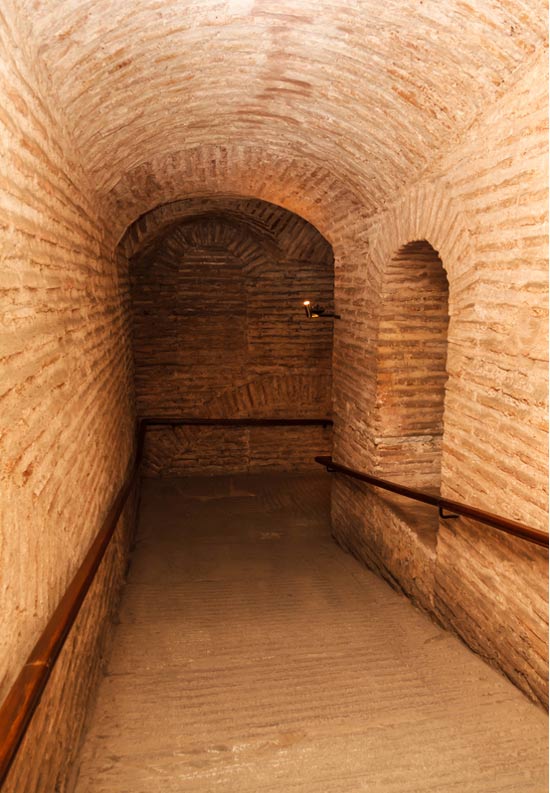
The Underground World of the Hagia Sophia
For over a thousand years until its fall to the Ottoman Turks in 1453, the city of Constantinople was one of the greatest urban centres in the Christian world. At the heart of this city was the Hagia Sophia (meaning ‘Holy Wisdom’ in Greek), one of the most iconic buildings of Constantinople. The current structure can be dated to the reign of the emperor Justinian in the 6 th century A.D., and is the third to be built on the site. Compared to its predecessors, Justinian’s basilica was an architectural feat, and a monument to the empire’s (and the emperor’s) greatness. None can deny that the Hagia Sophia is indeed a masterpiece. Yet, what is beneath this structure may be as interesting as, if not more than, what can be seen above ground.

The spectacular Hagia Sophia, Istanbul. Credit: BigStockPhoto
There are arguments for the existence of an extensive hidden area under the Hagia Sophia. For instance, it is well known that crypts were a common feature of the church architecture of the early Christian period. The Christian practice of burying the dead in crypts beneath churches was quite distinct from the pagan practice of burying the dead outside the walls of the city. Two of the most important churches in the Christian world during the 6 th century A.D., i.e. Old St. Peter’s in Rome and the Church of the Holy Sepulchre in Jerusalem, also had an underground area beneath them. In the case of the former, it was built over a cemetery and near a temple of an Etruscan god, whilst the latter was built over a temple dedicated to the Greek goddess Aphrodite. As Hagia Sophia was one of the most important churches in Christendom, it is expected that it would have an underground area as well, just like Old St. Peter’s and the Church of the Holy Sepulchre. Moreover, it is possible that like these two churches, the Hagia Sophia was also built over a pagan temple.
Yet, little is known about what lies underneath the Hagia Sophia, despite the fact that the structure has been investigated by researchers since 1935. According to one legend, the Devil was imprisoned underneath the Hagia Sophia. In another, Byzantine relics were said to be hidden by priests in secret chambers underneath the church prior to the city’s conquest by the Ottomans. These, however, are merely tales without much evidence to back them.
Though not directly beneath the Hagia Sophia, the well-known Basilica Cistern lies underground just 150 meters southwest of the ancient church and was built by the Byzantine emperor, Justinian I, in A.D. 532. This cistern is 138 m in length and 64.6 m in width, covering an area of almost 1,000 square metres. An incredible work effort went into its construction, with 336 marble columns supporting the structure, each measuring 9m in height, and arranged in 12 rows of 28 columns.
MORE
- The incredible subterranean Basilica Cistern
- Underground cities and networks around the World – Myths and Reality
- Secret underground tunnels of ancient Mesopotamian cult revealed under Ani ruins
- Massive 5,000-year-old underground city uncovered in Cappadocia, Turkey
In 1937, researchers began a survey of the underground area directly below the Hagia Sophia. This ended prematurely due to the start of the Second World War. In 1945, it was decided that the water under Hagia Sophia was to be removed for research purposes. The water level did not go down, and the pump’s motor burned out, thus bringing the undertaking to an end.

Exploring the underground tunnels beneath the Hagia Sophia. Source: YouTube – Hagia Sophia and Topkapi Palace (The Wells, Subterranean Channels and Water System)
In 2005, a survey of the wells in and around Hagia Sophia was carried out with the long-term aim of understanding the function of the underground tunnels and water system used for the building and its surrounding areas. The survey identified nine wells inside and around Hagia Sophia and its gardens. Five of these wells still contained water, and two were explored by the team. In addition, tunnels, which were used to provide ventilation and reduce humidity, were also found.
In 2009, the filmmaker Göksel Gülensoy produced a documentary that explored the subterranean region of Hagia Sophia. Gülensoy’s team was allowed to dive into two reservoirs that connected the church with the Topkapi Palace and the Underground Cistern. Near the bottom of the first reservoir, the divers found two thick pieces of wood, a bucket, and an animal skeleton. In the second reservoir, the team discovered a number of flasks dating to 1917, glass from the chandeliers of Hagia Sophia, a chain with two rings at the end, and bits of stained glass. It is claimed that the flasks were probably dropped by British soldiers trying to get some holy water when they invaded the city in 1917.

Dark hallway with polished pebbles on the floor passageway inside Hagia Sophia Basilica, Istanbu Turkey. Credit: Mikhail Starodubov | Dreamstime.com
The survey of 2005 and the documentary of 2009 are perhaps the first steps towards a greater understanding of the subterranean area of Hagia Sophia. It is certain that much more exploration and research would be needed before the secrets beneath the Hagia Sophia are yielded.
Featured image: Part of the Basilica Cistern, near the Hagia Sophia. Photo source: Wikimedia.
References
Özkan-Aygün, Ç., 2006. The Wells, Subterranean Passage, Tunnels and Water Systems of Hagia. Frankfurter elektronische Rundschau zur Altertumskunde, 2006(1), pp. 35-40.
www.hagiasophia.com, 2015. In the Depths of Hagia. [Online]
Available at: http://www.hagiasophia.com/listingview.php?listingID=28
www.hagiasophia.com, 2015. Tunnels of Hagia Sophia. [Online]
Available at: http://www.hagiasophia.com/listingview.php?listingID=38
www.nationalturk.com, 2013. What are the secrets of Hagia Sophia mentioned in Dan Brown’s latest novel Inferno / Istanbul News. [Online]
Available at: http://www.nationalturk.com/en/what-are-the-secrets-of-hagia-sophia-mentioned-in-dan-browns-latest-novel-inferno-istanbul-news-38003
Yedig, S., 2009. Diving into the secrets of Hagia Sophia. [Online]
Available at: http://www.hurriyetdailynews.com/default.aspx?pageid=438&n=diving-into-the-secrets-of-hagia-sophia-2009-08-04
By Ḏḥwty
















Comments
A wonderful site and effort...